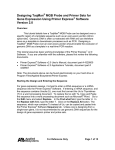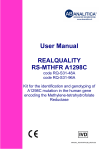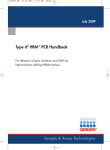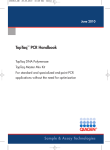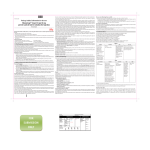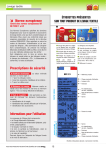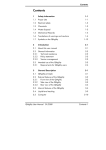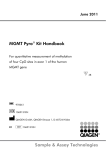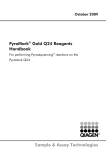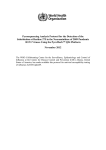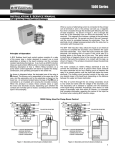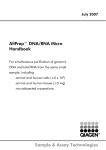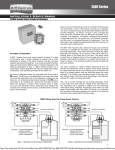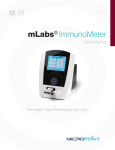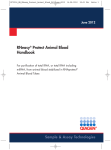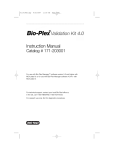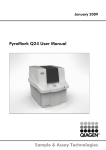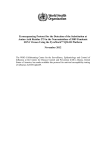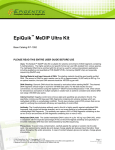Download PyroMark_Q24_PCR_Han..
Transcript
May 2009 PyroMark PCR Handbook For PCR amplification of template DNA optimized for Pyrosequencing® analysis Sample & Assay Technologies QIAGEN Sample and Assay Technologies QIAGEN is the leading provider of innovative sample and assay technologies, enabling the isolation and detection of contents of any biological sample. Our advanced, high-quality products and services ensure success from sample to result. QIAGEN sets standards in: Purification of DNA, RNA, and proteins Nucleic acid and protein assays microRNA research and RNAi Automation of sample and assay technologies Our mission is to enable you to achieve outstanding success and breakthroughs. For more information, visit www.qiagen.com. Contents Kit Contents 4 Shipping and Storage 4 Product Use Limitations 4 Product Warranty and Satisfaction Guarantee 5 Technical Assistance 5 Safety Information 5 Product Specifications 6 Quality Control 7 Introduction 8 Equipment and Reagents to Be Supplied by User 10 Protocols PCR Using PyroMark PCR Master Mix 11 PCR Using PyroMark PCR Master Mix and Q-Solution 15 Troubleshooting Guide 20 Appendix A: Starting Template 25 Appendix B: Assay and Primer Design, Handling and Storage of Primers 26 Appendix C: Control of Contamination 29 Ordering Information 31 PyroMark PCR Handbook 05/2009 3 Kit Contents PyroMark PCR Kit Catalog no. Reaction volume PyroMark PCR Master Mix, 2x * CoralLoad® Concentrate, 10x Q-Solution®, 5x (200) (800) 978703 978705 25 μl 25 μl 3 x 0.85 ml 12 x 0.85 ml 1 x 1.2 ml 4 x 1.2 ml 1 x 2 ml 4 x 2 ml MgCl2, 25 mM 1 x 1.2 ml 4 x 1.2 ml RNase-Free Water 1 x 1.9 ml 4 x 1.9 ml Handbook 1 1 * Includes HotStarTaq DNA Polymerase and optimized PyroMark Reaction Buffer containing 3 mM MgCl2 and dNTPs. Shipping and Storage The PyroMark PCR Kit is shipped on dry ice but retains full activity at room temperature (15–25°C) for 3 days. The kit should be stored immediately upon receipt at –20°C in a constant temperature freezer. When stored under these conditions and handled correctly, this product can be kept at least until the expiration date (see the inside of the kit lid) without showing any reduction in performance. Product Use Limitations The PyroMark PCR Kit is intended for molecular biology applications. These products are neither intended for the diagnosis, prevention, or treatment of a disease, nor have they been validated for such use either alone or in combination with other products. Therefore, the performance characteristics of the products for clinical use (i.e., diagnostic, prognostic, therapeutic, or blood banking) are unknown. All due care and attention should be exercised in the handling of the products. We recommend all users of QIAGEN products to adhere to the NIH guidelines that have been developed for recombinant DNA experiments, or to other applicable guidelines. 4 PyroMark PCR Handbook 05/2009 Product Warranty and Satisfaction Guarantee QIAGEN guarantees the performance of all products in the manner described in our product literature. The purchaser must determine the suitability of the product for its particular use. Should any product fail to perform satisfactorily due to any reason other than misuse, QIAGEN will replace it free of charge or refund the purchase price. We reserve the right to change, alter, or modify any product to enhance its performance and design. If a QIAGEN product does not meet your expectations, simply call your local Technical Service Department or distributor. We will credit your account or exchange the product — as you wish. Separate conditions apply to QIAGEN scientific instruments, service products, and to products shipped on dry ice. Please inquire for more information. A copy of QIAGEN terms and conditions can be obtained on request, and is also provided on the back of our invoices. If you have questions about product specifications or performance, please call QIAGEN Technical Services or your local distributor (see back cover or visit www.qiagen.com). Technical Assistance At QIAGEN, we pride ourselves on the quality and availability of our technical support. Our Technical Service Departments are staffed by experienced scientists with extensive practical and theoretical expertise in sample and assay technologies and the use of QIAGEN products. If you have any questions or experience any difficulties regarding the PyroMark PCR Kit or QIAGEN products in general, please do not hesitate to contact us. QIAGEN customers are a major source of information regarding advanced or specialized uses of our products. This information is helpful to other scientists as well as to the researchers at QIAGEN. We therefore encourage you to contact us if you have any suggestions about product performance or new applications and techniques. For technical assistance and more information, please see our Technical Support Center at www.qiagen.com/Support or call one of the QIAGEN Technical Service Departments or local distributors (see back cover or visit www.qiagen.com). Safety Information When working with chemicals, always wear a suitable lab coat, disposable gloves, and protective goggles. For more information, please consult the appropriate material safety data sheets (MSDSs). These are available online in convenient and compact PDF format at www.qiagen.com/support/MSDS.aspx where you can find, view, and print the MSDS for each QIAGEN kit and kit component. PyroMark PCR Handbook 05/2009 5 24-hour emergency information Emergency medical information in English, French, and German can be obtained 24 hours a day from: Poison Information Center Mainz, Germany Tel: +49-6131-19240 Product Specifications PyroMark PCR Master Mix, 2x : Enzyme: 2x concentrated. Contains HotStarTaq DNA Polymerase and optimized PyroMark PCR Buffer (contains 3 mM MgCl2 and dNTPs). HotStarTaq DNA Polymerase is a modified form of a recombinant 94 kDa DNA polymerase. Extension rate: Half-life: 5'–3' exonuclease activity: Extra A addition: 3'–5' exonuclease activity: Nuclease contamination: Protease contamination: RNase contamination: Self-priming activity: Buffers and reagents: Q-Solution: MgCl2 solution: CoralLoad Concentrate: 6 2–4 kb/min at 72°C 10 min at 97°C; 60 min at 94°C Yes Yes No No No No No 5x concentrated 25 mM 10x concentrated. Contains gel loading reagent, orange dye, red dye PyroMark PCR Handbook 05/2009 Quality Control Enzyme: (See quality-control label inside kit lid for lotspecific values.) Amplification efficiency assay: The amplification efficiency is tested in parallel amplification reactions and is indicated under “Amp”. PCR reproducibility assay: PCR reproducibility and specificity are tested in parallel amplification reactions. The reactions must yield a single specific product. Exonuclease activity assay: Linearized plasmid DNA is incubated with HotStarTaq DNA Polymerase in PCR Buffer. Exonuclease activity per unit of enzyme is indicated under “Exo”. Endonuclease activity assay: Plasmid DNA is incubated with HotStarTaq DNA Polymerase in PCR Buffer. Exonuclease activity per unit of enzyme is indicated under “Endo”. RNase activity assay: RNA is incubated with HotStarTaq DNA Polymerase in PCR Buffer. RNase activity per unit of enzyme is indicated under “RNase”. Protease activity assay: HotStarTaq DNA Polymerase is incubated in storage buffer. Protease activity per unit of enzyme is indicated under “Protease”. Self-priming activity assay: Assays are performed under standard PCR conditions, without primers, HotStarTaq DNA Polymerase and human genomic DNA (purified with the QIAamp® DNA Blood Mini Kit). The absence of PCR product is indicated by “No” under “Self priming”. Buffers and Reagents: CoralLoad Concentrate, 10x: Conductivity and dye concentrations are tested. Q-Solution, 5x: Conductivity, pH, total aerobic microbiological count, and performance in PCR are tested. MgCl2, 25 mM: Conductivity, total aerobic microbiological count, and performance in PCR are tested. RNase-free water: Conductivity and RNase activities are tested. PyroMark PCR Handbook 05/2009 7 Introduction The PyroMark PCR Kit is specifically optimized for Pyrosequencing analysis enabling highly specific and unbiased amplification of template DNA for various Pyrosequencing applications such as mutation detection, SNP analysis, methylation analysis, and sequencing. The convenient master mix format enables specific amplification of various starting materials using only one protocol. Bisulfite treatment of genomic DNA converts nonmethylated cytosines to uracils leading to DNA mainly consisting of three bases. This less complex DNA is a challenging PCR template and the PCR products obtained are likely to have low yields. Nonspecific products might be generated due to increased mispriming probability caused by the reduced complexity of DNA. The unique master mix solution ensures specifically targeted primer binding and prevents mispriming due to a balanced combination of salts included in the PCR buffer leading to a specific PCR product. An excess of biotinylated primer and artifacts generated during PCR can interfere with the Pyrosequencing procedure. The PyroMark PCR Kit is optimized for use during Pyrosequencing analysis. The specially-formulated master mix prevents accumulation of an excess of biotinylated primer and minimizes generation of artifacts. The high yields of specific PCR products obtained ensure reliable Pyrosequencing results. HotStarTaq DNA Polymerase HotStarTaq DNA Polymerase is a modified form of the recombinant 94 kDa Taq DNA Polymerase from QIAGEN. HotStarTaq DNA Polymerase is provided in an inactive state with no polymerase activity at ambient temperatures. This prevents the formation of misprimed products and primer–dimers at low temperatures. HotStarTaq DNA Polymerase is activated by a 15-minute, 95°C incubation step, which can easily be incorporated into existing thermal cycling programs. HotStarTaq DNA Polymerase provides high PCR specificity and often increases the yield of the specific PCR product. PCR setup is quick and convenient as all reaction components can be combined at room temperature. PyroMark PCR Master Mix The innovative master mix facilitates the amplification of specific PCR products from various starting materials, such as genomic DNA from a variety of species, as well as bisulfite converted DNA, thereby generating PCR products that are highly suitable for Pyrosequencing. During the annealing step of every PCR cycle, the unique buffer composition ensures a high ratio of specific-tononspecific primer binding. Owing to a uniquely balanced combination of KCl and (NH4)2SO4, the PCR buffer provides stringent primer-annealing conditions over a wider range of annealing temperatures and Mg2+ concentrations than conventional PCR buffers. Optimization of PCR by varying the annealing 8 PyroMark PCR Handbook 05/2009 temperature or the Mg2+ concentration is dramatically reduced and often not required. CoralLoad Concentrate PyroMark PCR Kit is supplied with CoralLoad Concentrate which is strongly recommended to be used with the PyroMark PCR Master Mix for highly specific PCR and high yields of amplified DNA. Furthermore, PCR products amplified in the presence of CoralLoad Concentrate can directly be loaded onto an agarose gel without the need to add a gel loading buffer since it contains a gel loading reagent and two marker dyes — an orange dye and a red dye — that facilitate estimation of DNA migration distance and optimization of agarose gel run time. CoralLoad Concentrate can be added to the PCR without affecting amplification sensitivity or specificity. PCR fragments amplified in the presence of CoralLoad Concentrate have been successfully tested for Pyrosequencing. Q-Solution The PyroMark PCR Master Mix is provided with Q-Solution, an innovative PCR additive that facilitates amplification of difficult templates by modifying the melting behavior of DNA. This unique reagent will often enable or improve a suboptimal PCR caused by difficult templates that for example have a high degree of secondary structure or templates that are GC-rich. Unlike other commonly used PCR additives such as DMSO, Q-Solution is used at just one working concentration, it is nontoxic, and PCR purity is guaranteed. PCR fragments amplified in the presence of Q-Solution have been successfully tested for Pyrosequencing. Specificity and sensitivity The PyroMark PCR Master Mix, with its balanced potassium and sodium salts, promotes specific primer–template annealing and simultaneously reduces nonspecific annealing. Maximum yields of specific products are obtained even when using extremely low template amounts. PyroMark PCR Handbook 05/2009 9 Equipment and Reagents to Be Supplied by User When working with chemicals, always wear a suitable lab coat, disposable gloves, and protective goggles. For more information, consult the appropriate material safety data sheets (MSDSs), available from the product supplier. Reaction tubes Pipets and pipet tips (aerosol resistant) Thermal cycler Mineral oil (only if the thermal cycler does not have a heated lid) Primers: Primers should be purchased from an established oligonucleotide manufacturer. Lyophilized primers should be dissolved in TE to provide a stock solution of 100 μM; concentration should be checked by spectrophotometry. Primer stock solutions should be stored in aliquots at –20°C (see Appendix B, page 28) 10 PyroMark PCR Handbook 05/2009 Protocol: PCR Using PyroMark PCR Master Mix Important points before starting One primer must be biotinylated at its 5’ end in order to prepare a single-stranded PCR product for use in the subsequent Pyrosequencing procedure. We recommend HPLC or an equivalent procedure to purify the biotinylated primer. For primer design we recommend use of PyroMark Assay Design Software 2.0. The optimal PCR amplicon length for Pyrosequencing is between 80 and 200 bp, although products up to 500 bp might work well for Pyrosequencing assays on genomic DNA. HotStarTaq DNA Polymerase requires an activation step of 15 min at 95°C (see step 6 of this protocol). PyroMark PCR Master Mix provides a final concentration of 1.5 mM MgCl2 in the final reaction mix, which will produce satisfactory results in most cases. However, if a higher Mg2+ concentration is required, use of the 25 mM MgCl2 provided in the kit is recommended. Set up all reaction mixtures in an area separate from that used for DNA preparation or PCR product analysis. Use disposable tips containing hydrophobic filters to minimize crosscontamination. Procedure 1. Thaw the PyroMark PCR Master Mix, CoralLoad Concentrate, primer solutions, and 25 mM MgCl2 (if required) at room temperature or on ice. It is important to mix the solutions before use in order to avoid localized concentrations of salt. 2. Set up the reaction according to Table 1. It is not necessary to keep reaction vessels on ice since HotStarTaq DNA Polymerase is inactive at room temperature. Note: The Mg2+ concentration in the PyroMark Reaction Buffer will produce satisfactory results in most cases. However, in some cases, reactions may be improved by increasing the final Mg2+ concentration according to Table 2. PyroMark PCR Handbook 05/2009 11 Table 1. Reaction composition using PyroMark PCR Master Mix Component Volume/reaction Final concentration PyroMark PCR Master Mix, 2x 12.5 μl Contains HotStarTaq DNA Polymerase,1x PyroMark PCR Buffer,* and dNTPs CoralLoad Concentrate, 10x 2.5 μl 1x 25 mM MgCl2 (optional) Variable, see Table 2 See Table 2 Primer A Variable 0.2 μM† Primer B Variable 0.2 μM† RNase-free water Variable – Variable ≤ 500 ng/reaction‡ Reaction mix Template DNA Template DNA, added at step 4 or 10–20 ng bisulfite converted DNA Total volume 25 μl Note: If other reaction volumes are used, reduce the amount of each component accordingly. * Contains 1.5 mM MgCl2. † Final primer concentration in the PCR reaction of 0.2 μM is normally optimal. ‡ We recommend using 1–10 ng human genomic DNA. If other DNA is used, adjust the amount according to the genome size (see Appendix A, page 26). Table 2. Final Mg2+ concentrations Final Mg2+ concentration in reaction (mM) Required volume of 25 mM MgCl2 per reaction (μl): 1.5 2.0 2.5 3.0 3.5 4.0 4.5 5.0 0 0.5 1 1.5 2 2.5 3 3.5 3. Gently pipet the master mix up and down for thorough mixing and dispense appropriate volumes into PCR tubes. 12 PyroMark PCR Handbook 05/2009 4. Add template DNA (≤ 500 ng/reaction) to the individual PCR tubes. We recommend 10 ng human genomic DNA or 10–20 ng bisulfite converted DNA. Note: If the template is not human genomic DNA, adjust the amount according to the genome size (see Appendix A, page 26). 5. When using a thermal cycler with a heated lid, do not use mineral oil. Proceed directly to step 6. Otherwise, overlay with approximately 100 μl mineral oil. 6. Program the thermal cycler according to the manufacturer’s instructions. Note: Each PCR program must start with an initial heat activation step at 95°C for 15 min. Table 3. Optimized cycling protocol when using PyroMark PCR Master Mix Additional comments Initial PCR activation step 15 min 95°C HotStarTaq DNA Polymerase is activated by this heating step 3-step cycling: Denaturation 30 s 94°C Annealing* 30 s 60°C For genomic DNA 56°C For bisulfite converted DNA Extension 30 s 72°C Number of cycles 45 Final extension 10 min 72°C * Recommended annealing temperature when using PyroMark Assay Design Software 2.0. In all other cases 5°C below the calculated Tm of the primers is a suitable temperature to start with. An annealing temperature that gives the highest specificity for the desired PCR product should be used. 7. Place the PCR tubes in the thermal cycler and start the cycling program. Note: After amplification, samples can be stored overnight at 2–8°C or at –20°C for longer storage. 8. Use 5–20 μl of a 25 μl PCR for subsequent Pyrosequencing analysis. PyroMark PCR Handbook 05/2009 13 Note: In most cases 5–10 μl of the PCR product gives satisfactory Pyrosequencing results when using the PyroMark MD instrument, 10–20 μl when using the PyroMark Q24 instrument, and 20 μl when using the PyroMark ID instrument. Adjust the amount of PCR product according to the instructions in the user manual of the specific instrument if required. We recommend checking your PCR product prior to Pyrosequencing analysis, e.g., by fast analysis on the QIAxcel® or by agarose gel analysis. PCR products can be directly loaded onto an agarose gel without prior addition of a PCR loading buffer and gel tracking dyes when using CoralLoad Concentrate. CoralLoad Concentrate contains a gel loading reagent and gel tracking dyes. Refer to Table 4 below to identify the dyes according to migration distance and agarose gel percentage and type. Note: Due to the high viscosity of the solution, apply the solution slowly into the wells of the agarose gel. Table 4. Migration distances of gel tracking dyes %TAE (TBE) agarose gel Red dye Orange dye 0.8 500 bp (270 bp) ~80 bp (<10 bp) 1.0 300 bp (220 bp) ~40 bp (<10 bp) 1.5 250 bp (120 bp) ~20 bp (<10 bp) 2.0 100 bp (110 bp) <10 bp (<10 bp) 3.0 50 bp (100 bp) <10 bp (<10 bp) 14 PyroMark PCR Handbook 05/2009 Protocol: PCR Using PyroMark PCR Master Mix and Q-Solution This protocol is designed for using Q-Solution in PCR assays. Q-Solution changes the melting behavior of DNA and can be used for PCR systems that do not work well under standard conditions. When using Q-Solution the first time for a particular primer–template pair, always perform parallel reactions with and without Q-Solution. This recommendation should also be followed if another PCR additive (such as DMSO) was previously used for a particular primer–template pair. When using Q-Solution, depending on the individual PCR assay, the following effects may be observed: Case A: Q-Solution enables amplification of a reaction which previously failed. Case B: Q-Solution increases PCR specificity in certain primer–template systems. Case C: Q-Solution has no effect on PCR performance. Case D: Q-Solution causes reduced efficiency or failure of a previously successful amplification reaction. In this case, addition of QSolution disturbs the previously optimal primer–template annealing. Therefore, when using Q-Solution for the first time for a particular primer–template system, always perform reactions in parallel with and without Q-Solution. PyroMark PCR Handbook 05/2009 15 Important points before starting When using Q-Solution for the first time in a particular primer–template system, it is important to perform parallel amplification reactions with and without Q-Solution. One primer must be biotinylated at its 5’ end in order to prepare a single-stranded PCR product for use in the subsequent Pyrosequencing procedure. We recommend HPLC or an equivalent procedure to purify the biotinylated primer. For primer design we recommend use of PyroMark Assay Design Software 2.0. The optimal PCR amplicon length for Pyrosequencing is between 80 and 200 bp, although products up to 500 bp might work well for Pyrosequencing assays on genomic DNA. HotStarTaq DNA Polymerase requires an activation step of 15 min at 95°C (see step 6 of this protocol). Set up all reaction mixtures in an area separate from that used for DNA preparation or PCR product analysis. Use disposable tips containing hydrophobic filters to minimize crosscontamination. Procedure 1. Thaw PyroMark PCR Master Mix, CoralLoad Concentrate, primer solutions, and Q-Solution at room temperature or on ice. It is important to mix the solutions before use in order to avoid localized concentrations of salt. When using Q-Solution, additional MgCl2 is usually not required. 2. Set up the reaction according to Table 5. It is not necessary to keep reaction vessels on ice since HotStarTaq DNA Polymerase is inactive at room temperature. 16 PyroMark PCR Handbook 05/2009 Table 5. Reaction composition using PyroMark PCR Master Mix Component Volume/reaction Final concentration PyroMark PCR Master Mix, 2x 12.5 μl Contains HotStarTaq DNA Polymerase,1x PyroMark PCR Buffer,* and dNTPs CoralLoad Concentrate, 10x 2.5 μl 1x 5 μl 1x Primer A Variable 0.2 μM† Primer B Variable 0.2 μM† RNase-free water Variable – Variable ≤ 500 ng/reaction‡ Reaction mix Q-Solution, 5x Template DNA Template DNA, added at step 4 or 10–20 ng bisulfite converted DNA Total volume 25 μl Note: If other reaction volumes are used, reduce the amount of each component accordingly. * Contains 1.5 mM MgCl2. † Final primer concentration in the PCR reaction of 0.2 μM is normally optimal. ‡ We recommend using 1–10 ng human genomic DNA. If other DNA is used, adjust the amount according to the genome size (see Appendix A, page 26). 3. Gently pipet the master mix up and down for thorough mixing and dispense appropriate volumes into PCR tubes. 4. Add template DNA (≤ 500 ng/reaction) to the individual PCR tubes. We recommend 10 ng human genomic DNA or 10–20 ng bisulfite converted DNA. Note: If the template is not human genomic DNA, adjust the amount according to the genome size (see Appendix A, page 26). 5. When using a thermal cycler with a heated lid, do not use mineral oil. Proceed directly to step 6. Otherwise, overlay with approximately 100 μl mineral oil. PyroMark PCR Handbook 05/2009 17 6. Program the thermal cycler according to the manufacturer’s instructions. Note: Each PCR program must start with an initial heat activation step at 95°C for 15 min. Table 6. Optimized cycling protocol when using PyroMark PCR Master Mix and Q-Solution Additional comments Initial PCR activation step 15 min 95°C HotStarTaq DNA Polymerase is activated by this heating step 3-step cycling: Denaturation 30 s 94°C Annealing* 30 s 60°C For genomic DNA 56°C For bisulfite converted DNA Extension 30 s 72°C Number of cycles 45 Final extension 10 min 72°C * Recommended annealing temperature when using PyroMark Assay Design Software 2.0. In all other cases 5°C below the calculated Tm of the primers is a suitable temperature to start with. An annealing temperature that gives the highest specificity for the desired PCR product should be used. 7. Place the PCR tubes in the thermal cycler and start the cycling program. Note: After amplification, samples can be stored overnight at 2–8°C or at –20°C for longer storage. 8. Use 5–20 μl of a 25 μl PCR for subsequent Pyrosequencing analysis. Note: In most cases 5–10 μl of the PCR gives satisfactory Pyrosequencing results when using the PyroMark MD instrument, 10–20 μl when using the PyroMark Q24 instrument, and 20 μl when using the PyroMark ID instrument. Adjust the amount of PCR product according to the instruments manual if required. We recommend checking your PCR product prior to Pyrosequencing analysis, e.g., by fast analysis on the QIAxcel or by agarose gel analysis. PCR products can be directly loaded onto an agarose gel without prior 18 PyroMark PCR Handbook 05/2009 addition of a PCR loading buffer and gel tracking dyes when using CoralLoad Concentrate. CoralLoad Concentrate contains a gel loading reagent and gel tracking dyes. Refer to Table 7 below to identify the dyes according to migration distance and agarose gel percentage and type. Note: Due to the high viscosity of the solution, apply the solution slowly into the wells of the agarose gel. Table 7. Migration distances of gel tracking dyes %TAE (TBE) agarose gel Red dye Orange dye 0.8 500 bp (270 bp) ~80 bp (<10 bp) 1.0 300 bp (220 bp) ~40 bp (<10 bp) 1.5 250 bp (120 bp) ~20 bp (<10 bp) 2.0 100 bp (110 bp) <10 bp (<10 bp) 3.0 50 bp (100 bp) <10 bp (<10 bp) PyroMark PCR Handbook 05/2009 19 Troubleshooting Guide This troubleshooting guide may be helpful in solving any problems that may arise. For more information, see also the Frequently Asked Questions page at our Technical Support Center: www.qiagen.com/FAQ/FAQList.aspx. The scientists in QIAGEN Technical Services are always happy to answer any questions you may have about either the information and protocols in this handbook or sample and assay technologies (for contact information, see back cover or visit www.qiagen.com). Comments and suggestions PCR-related errors Little or no product a) HotStarTaq DNA Polymerase not activated Check whether PCR was started with an initial incubation step at 95°C for 15 min. b) Pipetting error or missing reagent Repeat the PCR. Check the concentrations and storage conditions of reagents, including primers. Use 12.5 μl PyroMark Master Mix per 25 μl reaction. c) High GC content Using the same cycling conditions, repeat the PCR using Q-Solution. d) Primer concentration not optimal or primers degraded Repeat the PCR with different primer concentrations from 0.1–0.5 μM of each primer (in 0.1 μM steps). However, an excess of biotinylated primer might cause background in a Pyrosequencing assay. e) Problems with starting template Check the concentration, storage conditions, and quality of the starting template (see Appendix A, page 25). If necessary, make new serial dilutions of template nucleic acid from stock solutions. Repeat the PCR using the new dilutions. f) Problems with bisulfite conversion reaction Check the concentration, storage conditions, and quality of the bisulfite converted DNA. Efficient bisulfite conversion and removal of PCR inhibitors is essential for optimal results. Perform bisulfite treatment of nucleic acids from your sample using an appropriate bisulfite conversion. We recommend the use of the EpiTect Bisulfite Kit for conversion. 20 PyroMark PCR Handbook 05/2009 Comments and suggestions g) Primer design not optimal We strongly recommend use of the PyroMark Assay Design Software 2.0 for primer design. h) Incorrect denaturation temperature or time Denaturation should be at 94°C for 30 to 60 s. Ensure that the initial 15 min 95°C incubation step was performed as described in step 6 of the PCR protocols. i) Incorrect annealing temperature or time If possible perform annealing gradient from 50°C to 65°C and check PCR products on an agarose gel. Choose an annealing temperature that results in the highest specificity and yield. If a gradient PCR is not possible, decrease annealing temperature in 2°C steps. Annealing time should be between 30 and 60 s. j) Mg2+ concentration not optimal Perform PCR with different final concentrations of Mg2+, from 1.5–5.0 mM (in 0.5 mM steps) using the 25 mM MgCl2 solution provided. k) Too much/little master mix The PyroMark PCR Master Mix is 2x concentrated. Use 12.5 μl PyroMark Master Mix per 25 μl reaction. l) Problems with the thermal cycler Check the power to the thermal cycler and that the thermal cycler has been correctly programmed. m) PCR overlaid with mineral oil when using a thermal cycler with a heated lid When performing PCR in a thermal cycler with a heated lid, do not overlay the PCR samples with mineral oil if the heated lid is switched on as this may decrease the yield of PCR product. Product is multi-banded a) PCR cycling conditions not optimal Using the same cycling conditions, repeat the PCR using Q-Solution. Follow the protocol on page 15. b) Annealing temperature too low If possible perform annealing gradient from 50°C to 65°C and check PCR products on an agarose gel. Choose an annealing temperature that results in the highest specificity and yield. If a gradient PCR is not possible increase annealing temperature in 2°C steps. Annealing time should be between 30 and 60 s. PyroMark PCR Handbook 05/2009 21 Comments and suggestions c) Primer design not optimal We strongly recommend use of the PyroMark Assay Design Software 2.0 for primer design. d) Primer concentration not optimal or primers degraded Repeat the PCR with different primer concentrations from 0.1–0.5 μM of each primer (in 0.1 μM steps). However, an excess of biotinylated primer might cause background in a Pyrosequencing assay. Product is smeared a) Too much starting template Check the concentration and storage conditions of the starting template (see Appendix A, page 25). Make serial dilutions of template nucleic acid from stock solutions. Perform PCR using these serial dilutions. b) Primer design not optimal We strongly recommend use of the PyroMark Assay Design Software 2.0 for primer design. c) Primer concentration not optimal or primers degraded Repeat the PCR with different primer concentrations, from 0.1–0.5 μM of each primer (in 0.1 μM steps). However, an excess of biotinylated primer might cause background in a Pyrosequencing assay. d) Mg2+ concentration not optimal Perform PCR with different final concentrations of Mg2+, from 1.5–5.0 mM (in 0.5 mM steps) using the 25 mM MgCl2 solution provided. e) Carryover contamination If the negative-control PCR (without template DNA) shows a PCR product or a smear, replace all reagents. Use disposable pipet tips containing hydrophobic filters to minimize crosscontamination. Set up all reaction mixtures in an area separate from that used for DNA preparation or PCR product analysis. f) Too much/little master mix The PyroMark PCR Master Mix is 2x concentrated. Use 12.5 μl PyroMark Master Mix per 25 μl reaction. g) Too many cycles Reduce the number of cycles in steps of 3 cycles. 22 PyroMark PCR Handbook 05/2009 Comments and suggestions Pyrosequencing-related errors Low or missing peaks in the Pyrosequencing run a) Primer is insufficiently or not biotinylated Ensure that PCR primers are of high quality (use HPLC-purified biotinylated primers). One of the primers must be biotin-labeled to enable immobilization to streptavidin-coated beads during preparation of a single-stranded Pyrosequencing template. b) Sequencing primer does not match to the biotinylated strand Check that the sequencing primer binds to the biotinylated strand. c) Low-quality Pyrosequencing template Recommended PCR conditions will result in high-quality Pyrosequencing templates in most cases. Optimize PCR if required (see above). However, we recommend inspection of your PCR product on agarose gels. Be sure to only use single-banded templates with a sufficient yield for Pyrosequencing. d) Assay design not optimal We strongly recommend use of the PyroMark Assay Design Software 2.0 for designing PCR and sequencing primers to ensure correct primer design and orientation. e) Sample preparation and Pyrosequencing workflow-related errors Please refer to the user manual for the PyroMark instrument which is used. PyroMark PCR Handbook 05/2009 23 Comments and suggestions Poor or faulty Pyrosequencing run e) Background of contaminating sequence from PCR Check your PCR product on agarose gels to confirm that you only have one specific product. Additional sequence signals can be caused by miscellaneous events such as: Duplex-formation of sequencing primer and/or biotinylated primer Hairpin formation of biotinylated primer and/or template loop on Pyrosequencing template Annealing between the sequencing primer and the biotinylated PCR primer Nonspecific annealing of the sequencing primer to Pyrosequencing template Be sure to include following controls when you run an assays the first time: PCR without DNA Sequencing primer on its own Template without sequencing primer For more information, see the user manual for the specific Pyrosequencing instrument. We strongly recommend using PyroMark Assay Design Software 2.0 for designing PCR and sequencing primers suitable for Pyrosequencing. 24 PyroMark PCR Handbook 05/2009 Appendix A: Starting Template Both the quality and quantity of nucleic acid starting template affect PCR, in particular the sensitivity and efficiency of amplification. Quality of starting template Since PCR consists of multiple rounds of enzymatic reactions, it is more sensitive to impurities such as proteins, phenol/chloroform, salts, ethanol, EDTA, and other chemical solvents than single-step enzyme-catalyzed processes. QIAGEN offers a complete range of nucleic acid preparation systems, ensuring the highest-quality templates for PCR. These include the QIAprep® system for rapid plasmid purification, the QIAamp® and DNeasy® systems for rapid purification of genomic DNA and viral nucleic acids, and the RNeasy® system for RNA preparation from a variety of sources. For more information about QIAprep, QIAamp, DNeasy, and RNeasy products, contact one of our Technical Service Departments (see back cover) or visit www.qiagen.com/productfinder. Quality of starting template when performing CpG assays Critical parameters for a successful PCR using bisulfite-treated DNA template include complete bisulfite conversion and DNA fragments that are long enough for PCR. The EpiTect Bisulfite Kit provides a fast and reliable procedure for efficient bisulfite conversion and prevents DNA fragmentation during the bisulfite conversion reaction by a unique DNA Protect Buffer. For more information about EpiTect products, contact one of our Technical Service Departments (see back cover or visit www.qiagen.com). Quantity of starting template The annealing efficiency of a primer to template is an important factor in PCR. Owing to the thermodynamic nature of the reaction, the primer:template ratio strongly influences the specificity and efficiency of PCR and should be optimized empirically. If too little template is used, primers may not be able to find their complementary sequences. Too much template may lead to an increase in mispriming events. As an initial guide, spectrophotometric and molar conversion values for different nucleic acid templates are listed in Tables 8 and 9, respectively. PyroMark PCR Handbook 05/2009 25 Table 8. Spectrophotometric conversions for nucleic acid templates 1 A260 unit* Concentration (μg/ml) Double-stranded DNA 50 Single-stranded DNA 33 Single-stranded RNA 40 * Absorbance at 260 nm = 1 Table 9. Molar conversions for nucleic acid templates Nucleic acid Size pmol/μg Molecules/μg 1 kb DNA 1000 bp 1.52 9.1 x 1011 pUC19 DNA 2686 bp 0.57 3.4 x 1011 Lambda DNA 48,502 bp 0.03 1.8 x 1010 Escherichia coli 4.7 x 106* 3.0 x 10–4 1.8 x 108† Drosophila melanogaster 1.4 x 108* 1.1 x 10–5 6.6 x 105† Mus musculus (mouse) 2.7 x 109* 5.7 x 10–7 3.4 x 105† Homo sapiens (human) 3.3 x 109* 4.7 x 10–7 2.8 x 105† Genomic DNA * Base pairs in haploid genome. † For single-copy genes. Appendix B: Assay and Primer Design, Handling and Storage of Primers Assay and primer design Primers should be designed using PyroMark Assay Design Software 2.0. The program automatically generates primer sets that include both PCR and sequencing primers. Each primer set is given a quality score based on several parameters that are specific for Pyrosequencing analysis. 26 PyroMark PCR Handbook 05/2009 PCR primer PCR primers should be 18 to 24 bases in length, with annealing temperatures that are similar and typically in the range of 50°C to 68°C (nearest neighbor method). When using PyroMark Assay Design Software 2.0 for primer design, an annealing temperature of 60°C for genomic DNA gives good results in most cases. If you are not using PyroMark Assay Software 2.0, 5°C below the calculated Tm of the primers is a suitable temperature to start with. However, the annealing temperature with highest specificity for the desired PCR product should be used. One of the primers must be biotin-labeled to enable immobilization of the PCR product to streptavidin-coated beads during the preparation of single-stranded Pyrosequencing template. The orientation of the assay can either be forward or reverse. The primer that needs to be biotinylated is indicated by the PyroMark Assay Design Software 2.0. The primers should not form strong hairpin loops or dimers with themselves or with the other primers. The biotinylated primer should be carefully checked for hairpin loops and duplexes with the sequencing primer, as excess biotinylated primer might cause background in Pyrosequencing assays. If possible, avoid placing primers over polymorphic positions. The biotinylated primer should be purified by HPLC or an equivalent procedure since free biotin will compete with the biotinylated PCR product for binding on streptavidin-coated beads. Amplicon length The optimal amplicon length is between 80 and 200 bp, although products up to 500 bp might work well. Sequencing primer The sequencing primer should be 15 to 20 bases long and have an annealing temperature in the range of 45°C to 55°C. Ideally, the sequencing primer should differ from the PCR primer by at least one additional, specific base at the 3’ end. Specific considerations for CpG assays In CpG assays, the optimal length of the primers is slightly increased to function on bisulfite-treated DNA, which has a high proportion of A and T. PCR primers should usually be 22–30 bases and sequencing primers should be 18–23 bases in length. When using PyroMark Assay Design Software 2.0 for primer design, an annealing temperature of 56°C for bisulfite converted DNA gives good results in most cases. The amplicons for CpG assays should ideally be shorter than 200 bp. PyroMark PCR Handbook 05/2009 27 If sequences have densely packed CpG sites, the design may require manual intervention. However, the penalties and scores given by the PyroMark Assay Design Software 2.0 are still very informative. Manual operations for CpG assay design can include: Looking for the region of most interest and selecting it as the target. Placing the PCR primer without covering more than one CpG site. Ensuring the CpG site is in the 5’ part of the primer, if a primer needs to be located over a CpG site. Looking for warnings and checking for analysis parameters that can be improved (Tm for primers, mispriming, duplexes between biotinylated primer and sequencing primer, amplicon length, etc). Trying to improve the final score by changing the length of the primers and by moving them back and forth. Handling and storage of primers Determining primer concentration and quality Primer quality is crucial for successful PCR. Problems encountered with PCR are frequently due to incorrect concentrations of primers being used. If you observe problems in yield of amplification products, check that primers were used at the correct concentration. Storage buffer Lyophilized primers should be dissolved in a small volume of low-salt buffer to give a concentrated stock solution (e.g., 100 μM). We recommend using TE buffer (10 mM Tris·Cl, 1 mM EDTA, pH 8.0). Dissolving primers Before opening a tube containing lyophilized primer, centrifuge the tube briefly to collect all material at the bottom of the tube. To dissolve the primer, add the required volume of sterile, nuclease-free TE buffer, mix, and leave for 20 minutes to allow the primer to completely dissolve. Mix again and determine the concentration by spectrophotometry as described below. We do not recommend dissolving primers in water. They are less stable in water than in TE buffer and some may not dissolve easily in water. 28 PyroMark PCR Handbook 05/2009 Concentration Spectrophotometric conversion for primers: 1 A260 unit = 20–30 μg/ml To check primer concentration, the molar extinction coefficient (ε260) can be used: A260 = ε260 x molar concentration of primer or probe If the ε260 value is not given on the data sheet supplied with the primers, it can be calculated from the primer sequence using the following formula: ε260 = 0.89 x [(A x 15,480) + (C x 7340) + (G x 11,760) + (T x 8850)] Example Concentration of diluted primer: 1 μM = 1 x 10–6 M Primer length: 24 nucleotides with 6 each of A, C, G, and T bases Calculation of expected A260: 0.89 x [(6 x 15,480) + (6 x 7340) + (6 x 11,760) + (6 x 8850)] x (1 x 10–6) = 0.232 The measured A260 should be within ±30% of the theoretical value. If the measured A260 is very different to the theoretical value, we recommend recalculating the concentration of the primers, or having the primers resynthesized. Storage of primers Primers should be stored in TE in small aliquots at –20°C. Primers are stable under these conditions for at least one year. Prepare small aliquots of working solutions containing 10 pmol/μl to avoid repeated thawing and freezing. Primer quality can be checked on a denaturing polyacrylamide gel;* a single band should be seen. Appendix C: Control of Contamination It is extremely important to include at least one negative control that lacks the template nucleic acid in every PCR setup to detect possible contamination. General physical precautions Separate the working areas for setting up the PCR master mix and DNA handling, including the addition of starting template, PCR product analysis, or plasmid preparation. Ideally, use separate rooms. Use a separate set of pipets for the PCR master mix. Use of pipet tips with hydrophobic filters is strongly recommended. * When working with chemicals, always wear a suitable lab coat, disposable gloves, and protective goggles. For more information, consult the appropriate material safety data sheets (MSDSs), available from the product supplier. PyroMark PCR Handbook 05/2009 29 Prepare and freeze small aliquots of primer solutions. Use of fresh distilled water is strongly recommended. In case of contamination, laboratory benches, apparatus, and pipets can be decontaminated by cleaning them with a 1/10 dilution of a commercial bleach solution.* † Afterwards, the benches and pipets should be rinsed with distilled water. General chemical precautions PCR stock solutions can also be decontaminated using UV light. This method is laborious, however, and its efficiency is difficult to control and cannot be guaranteed. We recommend storing solutions in small aliquots and using fresh aliquots for each PCR. Another approach to preventing amplification of contaminating DNA is to treat individual reaction mixtures with DNase I or restriction enzymes that cut between the binding sites of the amplification primers used, before adding the template DNA sample. * When working with chemicals, always wear a suitable lab coat, disposable gloves, and protective goggles. For more information, consult the appropriate material safety data sheets (MSDSs), available from the product supplier. † Most commercial bleach solutions are approximately 5.25% sodium hypochlorate. 30 PyroMark PCR Handbook 05/2009 Ordering Information Product Contents Cat. no. EpiTect Bisulfite Kits — for complete bisulfite conversion and cleanup of DNA for methylation analysis EpiTect Bisulfite Kit (48) 48 EpiTect Bisulfite Spin Columns, Reaction Mix, DNA Protect Buffer, Carrier RNA, Buffers 59104 EpiTect 96 Bisulfite Kit (2) 2x EpiTect Bisulfite 96-well Plates, Reaction Mix, DNA Protect Buffer, Carrier RNA, Buffers 59110 EpiTect Control DNA — for evaluation of PCR primers used for methylation analysis EpiTect Control DNA, methylated (100) Methylated and bisulfite converted human control DNA for 100 control PCRs 59655 EpiTect Control DNA, unmethylated (100) Unmethylated and bisulfite converted human control DNA for 100 control PCRs 59665 EpiTect Control DNA (1000) Unmethylated human control DNA for 1000 control PCRs 59568 EpiTect PCR Control DNA Set (100) Human control DNA set (containing both bisulfite converted methylated and unmethylated DNA and unconverted unmethylated DNA) for 100 control PCRs 59695 PyroMark Gold Reagents — for performing Pyrosequencing reactions PyroMark Gold Q24 Nucleotides, enzyme, and substrate Reagents (5 x 24) solutions, intended for use with PyroMark Q24 978002 PyroMark Gold Q96 Reagents (5 x 96) For performing Pyrosequencing reactions on the PyroMark Q96 ID (5 x 96) and PyroMark Q96 MD (15 x 96) 972804 PyroMark Gold Q96 Reagents (50 x 96) For performing Pyrosequencing reactions on the PyroMark Q96 MD and the PyroMark Q96 ID 972807 PyroMark PCR Handbook 05/2009 31 Product Contents Cat. no. PyroMark Gold Q96 SQA Reagents (1 x 96) For performing Pyrosequencing reactions on the PyroMark Q96 ID 972812 PyroMark Gold Q96 CDT Reagents (6 x 96) For performing Pyrosequencing reactions on the PyroMark Q96 MD in combination with the capillary dispensing tips (CDT) 972824 PyroMark Q24 Tests — PCR primer and sequencing primer for quantification of methylation status and mutation detection PyroMark Q24 CpG p16 (4 x 24) For quantification of methylation level in the p16 gene 970012 PyroMark Q24 CpG MLH1 (4 x 24) For quantification of methylation level in the promoter region of the MLH1gene 970022 PyroMark Q24 CpG MGMT (4 x 24) For quantification of methylation level in the MGMT gene 970032 PyroMark Q24 CpG LINE-1 (4 x 24) For quantification of global methylation level in transposable elements 970042 PyroMark Q24 BRAF (4 x 24) For detection of mutations in exon 11 and mutation V600E in exon 15 as well as surrounding mutations in the BRAF gene 970412 PyroMark Q24 KRAS (4 x 24) For detection of mutations in codons 12, 13, and 61 of the KRAS gene 970402 PyroMark Q24 KRAS v2.0 (4 x 24) For detection of mutations in codons 12, 13, and 61 of the KRAS gene; optimized for FFPE material 970452 PyroMark Q96 Tests — PCR primer and sequencing primer for quantification of methylation status and mutation detection PyroMark Q96 CpG p16 (96) 32 For quantification of methylation level in the p16 gene (2 x 96 reactions on PyroMark Q96 MD and 1 x 96 reactions on PyroMark Q96 ID) 972012 PyroMark PCR Handbook 05/2009 Product Contents Cat. no. PyroMark Q96 CpG MLH1 (96) For quantification of methylation level in promoter region of the MLH1 gene (2 x 96 reactions on PyroMark Q96 MD and 1 x 96 reactions on PyroMark Q96 ID) 972022 PyroMark Q96 CpG MGMT (96) For quantification of methylation level in the MGMT gene (2 x 96 reactions on PyroMark Q96 MD and 1 x 96 reactions on PyroMark Q96 ID) 972032 PyroMark Q96 CpG Prader-Willi (96) For quantification of methylation level in Prader-Willi and Angelman Syndromes (2 x 96 reactions on PyroMark Q96 MD and 1 x 96 reactions on PyroMark Q96 ID) 972052 PyroMark Q96 BRAF (96) For detection of mutations in exon 11 and mutation V600E in exon 15 as well as surrounding mutations in the BRAF gene (2 x 96 reactions on PyroMark Q96 MD and 1 x 96 reactions on PyroMark Q96 ID) 972412 PyroMark Q96 KRAS (96) For detection of mutations in codons 12, 13, and 61 of the KRAS gene (2 x 96 reactions on PyroMark Q96 MD and 1 x 96 reactions on PyroMark Q96 ID) 972402 PyroMark Q96 KRAS v2.0 (96) For detection of mutations in codons 12, 13, and 61 of the KRAS gene; optimized for FFPE material (2 x 96 reactions on PyroMark Q96 MD and 1 x 96 reactions on PyroMark Q96 ID) 972452 PyroMark Q96 APOE (96) For detection of polymorphism in the APOE gene (2 x 96 reactions on PyroMark Q96 MD and 1 x 96 reactions on PyroMark Q96 ID) 972422 PyroMark Q96 MTHFR (96) For detection of variants in the MTHFR gene (2 x 96 reactions on PyroMark Q96 MD and 1 x 96 reactions on PyroMark Q96 ID) 972432 PyroMark PCR Handbook 05/2009 33 Product Contents Cat. no. PyroMark Q96 HFE (96) For detection of variants in the HFE gene (2 x 96 reactions on PyroMark Q96 MD and 1 x 96 reactions on PyroMark Q96 ID) 972442 PyroMark Q96 CpG LINE-1 (2 x 96) For quantification of global methylation level in transposable elements; only for use with PyroMark Q96 MD 973043 PyroMark Q24 KRAS, PyroMark Q24 KRAS v2.0, PyroMark Q96 KRAS (96), and PyroMark Q96 KRAS v2.0 (96) are intended for research use only. Not for use in diagnostic procedures. No claim or representation is intended to provide information for the diagnosis, prevention, or treatment of a disease. For up-to-date licensing information and product-specific disclaimers, see the respective QIAGEN kit handbook or user manual. QIAGEN kit handbooks and user manuals are available at www.qiagen.com or can be requested from QIAGEN Technical Services or your local distributor. 34 PyroMark PCR Handbook 05/2009 Trademarks: QIAGEN®, QIAamp®, QIAprep®, QIAxcel®, CoralLoad®, DNeasy®, EpiTect®, Pyrosequencing®, Q-Solution®, RNeasy® (QIAGEN Group). Limited License Agreement Use of this product signifies the agreement of any purchaser or user of the PyroMark PCR Kit to the following terms: 1. The PyroMark PCR Kit may be used solely in accordance with the PyroMark PCR Handbook and for use with components contained in the Kit only. QIAGEN grants no license under any of its intellectual property to use or incorporate the enclosed components of this Kit with any components not included within this Kit except as described in the PyroMark PCR Handbook and additional protocols available at www.qiagen.com. 2. Other than expressly stated licenses, QIAGEN makes no warranty that this Kit and/or its use(s) do not infringe the rights of third-parties. 3. This kit and its components are licensed for one-time use and may not be reused, refurbished, or resold. 4. QIAGEN specifically disclaims any other licenses, expressed or implied other than those expressly stated. 5. The purchaser and user of the kit agree not to take or permit anyone else to take any steps that could lead to or facilitate any acts prohibited above. QIAGEN may enforce the prohibitions of this Limited License Agreement in any Court, and shall recover all its investigative and Court costs, including attorney fees, in any action to enforce this Limited License Agreement or any of its intellectual property rights relating to the Kit and/or its components. For updated license terms, see www.qiagen.com. © 2009 QIAGEN, all rights reserved. www.qiagen.com Australia Orders 03-9840-9800 Fax 03-9840-9888 Technical 1-800-243-066 Austria Orders 0800/28-10-10 Fax 0800/28-10-19 Technical 0800/28-10-11 Belgium Orders 0800-79612 Fax 0800-79611 Technical 0800-79556 Brazil Orders 0800-557779 Fax 55-11-5079-4001 Technical 0800-557779 Canada Orders 800-572-9613 Fax 800-713-5951 Technical 800-DNA-PREP (800-362-7737) China Orders 0086-21-3865-3865 Fax 0086-21-3865-3965 Technical 800-988-0325, 800-988-0327 Denmark Orders 80-885945 Fax 80-885944 Technical 80-885942 Finland Orders 0800-914416 Fax 0800-914415 Technical 0800-914413 France Orders 01-60-920-926 Fax 01-60-920-925 Technical 01-60-920-930 Offers 01-60-920-928 Germany Orders 02103-29-12000 Fax 02103-29-22000 Technical 02103-29-12400 Hong Kong Orders 800 933 965 Fax 800 930 439 Technical 800 930 425 Ireland Orders 1800 555 049 Fax 1800 555 048 Technical 1800 555 061 Italy Orders 02-33430-420 Fax 02-33430-426 Technical 800-787980 Japan Telephone 03-6890-7300 Fax 03-5547-0818 Technical 03-6890-7300 Korea (South) Orders 1544 7145 Fax 1544 7146 Technical 1544 7145 Luxembourg Orders 8002-2076 Fax 8002-2073 Technical 8002-2067 Mexico Orders 01-800-7742-639 Fax 01-800-1122-330 Technical 01-800-7742-639 The Netherlands Orders 0800-0229592 Fax 0800-0229593 Technical 0800-0229602 Norway Orders 800-18859 Fax 800-18817 Technical 800-18712 Singapore Orders 65-67775366 Fax 65-67785177 Technical 65-67775366 Spain Orders 91-630-7050 Fax 91-630-5145 Technical 91-630-7050 Sweden Orders 020-790282 Fax 020-790582 Technical 020-798328 Switzerland Orders 055-254-22-11 Fax 055-254-22-13 Technical 055-254-22-12 UK Orders 01293-422-911 Fax 01293-422-922 Technical 01293-422-999 USA Orders 800-426-8157 Fax 800-718-2056 Technical 800-DNA-PREP (800-362-7737) 1056834 05/2009 Sample & Assay Technologies




































